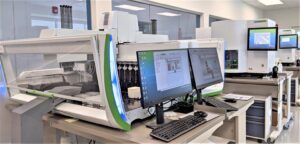Sema4 harnesses 21st century technologies like AI and machine learning to glean healthcare insights from genomic and clinical data. But the self-described “patient-centered health intelligence company” likens its mission to its near-namesake that originated two centuries earlier—the maritime flag signaling system known as semaphore. “Our team will discern signal from noise across trillions of data points in pursuit of our mission to gain meaningful insights into human health and disease,” declares the company’s website.
Last Friday (July 23), Sema4 signaled its intent to grow into a juggernaut of precision medicine by going public. The company raised about $500 million through a business combination completed with CM Life Sciences, a Special Purpose Acquisition Company (SPAC) sponsored by affiliates of noted life sciences investor Eli Casdin’s Casdin Capital ($3.3 billion assets under management) and Corvex Management, a hedge fund manager and investment advisor with $2.5 billion assets under management founded by CM’s former chairman Keith A. Meister.
The business combination and a concurrent $350 million private investment in public equity (PIPE), first announced in February, were approved by CM shareholders on Wednesday. Two days later, the combined company’s Class A common stock and warrants began trading on the NASDAQ Global Select Market under the symbols “SMFR” and “SMFRW,” respectively. Shares of Sema4 opened at $11.40 and rose 4% to $11.86 Friday before falling nearly 4%, to $11.42 at the close of trading on Monday.

Sema4 was formed in October 2015 as Mount Sinai Genomics, and began operations when it spun out of Mount Sinai in 2017. “Sema4 was driven by how can we leverage what we are doing in testing, how do you engage physicians and patients through standard of care and have them as partners?” Schadt told Clinical OMICs last year.
Since the spinout, Sema4 has grown to generate and process more than 30 petabytes of data per month, growing by almost 1 petabyte per month, and maintaining a database that includes close to 12 million de-identified clinical records, many with genomic profiles integrated to enable physicians to proactively diagnose and manage disease.
Sema4’s products include Sema4 Signal® precision oncology solutions designed to identify, treat, and monitor cancer, including a 2,200-gene pan-cancer panel and an 18,500-gene test combining whole exome sequencing (WES) with whole transcriptome sequencing; reproductive and prenatal testing analyses that include a carrier screen for more than 283 inherited conditions; testing, service, and support solutions for women’s health; advanced genomics profiling solutions for biopharmas; and COVID-19 testing solutions.
As part of the SPAC transaction, Sema4 appointed to its board four new members with impressive life-sciences backgrounds, including Casdin; Twist Bioscience CEO and co-founder Emily Leproust, PhD; Jason Ryan, most recently chief operating and financial officer of Magenta Therapeutics; and Nat Turner, co-founder of Flatiron Health, a Roche company.
They join directors Dennis S. Charney, MD, Dean of the Icahn School of Medicine at Mount Sinai; Michael Pellini, MD, a managing partner of the venture capital fund Section 32; Joshua Ruch, co-founder and CEO of Rho Capital Partners; Rachel Sherman, MD, MPH, FACP, president of the medical product development and consultancy Rachel Sherman Partners; and Eric Schadt, PhD, Sema4’s founder and CEO.
Schadt is a mathematician and data scientist who has led efforts to construct predictive models of disease that link molecular biology to physiology for more than 20 years, with the ultimate goal of improving patient health. Schadt is also the Dean for Precision Medicine and Mount Sinai professor in predictive health and computational biology at Icahn Mount Sinai, where he earlier served as founding director of the Icahn Institute for Genomics and Multiscale Biology, and professor and chair of the Department of Genetics and Genomic Sciences.
Before joining Mount Sinai in 2011, he was Chief Scientific Officer at Pacific Biosciences; Executive Scientific Director of Genetics at Rosetta Inpharmatics, a subsidiary of Merck & Co., and earlier was a senior research scientist at Roche Bioscience.
Schadt recently discussed Sema4’s SPAC transaction and approach to precision medicine with GEN Edge.
GEN Edge: Eric, why did Sema4 go public?
Eric Schadt, PhD: After we closed our series C round in the late summer of 2020, as we started getting traction on offering more holistic precision medicine solutions into health systems, we looked at the lift that’s required, some of the gaps that we wanted to fill, and what would it take to fill those, both organically and inorganically. We decided given the momentum needed that we had to leverage the public markets. The forward looking-ness of the public markets versus the private markets, and the ability to raise the right kinds of capital to be competitive in that kind of a play were the main drivers of why we decide to push into the public sphere.
GEN Edge: How and why did Sema4 choose to go public through a SPAC?
Schadt: We chose a SPAC over a traditional IPO because we also felt we were deciding to go out a little earlier than maybe would have been best for a traditional IPO, so we needed to do a lot of work to be able to operate as a public company.
As we explored the SPAC space and connected with Eli Casdin, it became clear that that kind of vehicle with that kind of a high-end, deep investor in this arena was a good partner to help bolster the credibility of where Sema4 wanted to push—and bring investors along as we prepared to be a public company. It was a matter of having more time through the SPAC to be ready to be a public company. Raising money in a hot market before we had everything ready to be public was very attractive.
GEN Edge: SPACs generally raise more money than traditional IPOs. How important a consideration was that for Sema4?
Schadt: Yes, definitely. To leverage the hot market, to get enhanced valuation, raise more money through both the SPAC and then the PIPE definitely was attractive as well.
GEN Edge: How did Sema4 connect with CM Life Sciences and a top-tier investor like Eli Casdin?
Schadt: As we explored whether we should be a SPAC or an IPO, we looked at the SPAC market at the time. Q4 of 2020 was crazy, as you know. We wanted to just focus on the really high-end SPACs, those with really credible health-oriented investors in the mix, SPACs that could be really helpful, because we were a little earlier than would have been optimal for a traditional IPO. I would say we looked at maybe ten SPACs.
I’ve known Eli for a long time since I’ve been in New York. In linking with investors early on in the process, it was definitely a “love-at-first-sight” thing, just getting Eli’s prowess in this. He’s an unusual investor, and he’s considered a key opinion leader in the genomics space. Given his mastery of the space and the performance of his funds, and just deep knowledge and connectivity, it was clear that having somebody like that alongside me to go through all the steps to go public and raise money in the PIPE round and so on, would just be the most ideal partner.
GEN Edge: Sema4’s proxy filing discusses the enabling of selective acquisitions among advantages of the SPAC. In which areas does Sema4 think needs to grow through M&A?
Schadt: The push is, how do we deliver holistic precision medicine solutions, enabling that as a standard of care in the hands of physicians and health systems? The standardized genomics platform we have spans a broad swath of disease, from the reproductive health side to population health, genomic health screening, drug safety, heritable cancer, on into the somatic profiling.
But one of the key gaps we have on the somatic profiling side is, we have this whole exome transcriptome product for tumor profiling, but we have nothing in the liquid biopsy arena, in particular MRD [minimal residual disease] and surveillance type testing. Those are key active internal explorations, as well as external canvassing in those areas.
We are partnering our genomics platform with our analytics platform, what we call Centrellis™, to help standardize all of that information that we’re generating—both information in the health systems through the EMRs [electronic medical records] and so on—and looking for commoditized parts of that platform, for example pulling in higher and higher scales of structured data and mapping that into common data models, and harmonizing that data, and so on.
We don’t think that we necessarily have to be the ones doing all of the more commoditized activity. Having a partner with others who have dedicated a lot of energy and resources behind that—whether that’s a partnership or an acquisition—are the kinds of things that we’re thinking about.
GEN Edge: How will the SPAC enable further development of Centrellis?
Schadt: Ultimately, the goal of Centrellis is a platform; I like to think of it as a platform of algorithms. We’re deriving and managing very large-scale data, both clinical through the EMRs as well as molecular data, genomic data, and so on. The aim is to derive insights from those data that help in standard of care flows deliver better interpretations, better insights to the patients and to the physicians, better outcomes.
There’s the work required to fully leverage millions of patients’ worth of data to extract from the unstructured data physician notes, imaging data, destruction of data, not just in cancer but across all disease conditions to better construct individualized health course trajectories of patients. Then there’s the scaling of that information resource that provides access to who wants to bang their data off our algorithms to get differentiated insights. We don’t feel like we need to be the one generating the data necessarily, that we can leverage data that others have generated and leverage that platform to gain those insights. So there’s a lot of development work scaling the data science side to better mine all that information and develop a broader array of algorithms to leverage algorithms that others are building on the outside to plug into the platform, and so on. There’s a lot of development work, a lot of data science scaling that goes along with that.
GEN Edge: Will Centrellis be used more for drug discovery as a result of the SPAC, as opposed to precision medicine data collection and application?
Schadt: My view is, once you have this platform of algorithms that are creating better models of disease to better inform on disease conditions, on diagnosis, on risk assessments and so on, of course that has direct utility across the drug life cycle development in the pharmaceutical arena, from better models of disease that could be leverage for better drug discovery, better target identification and prioritization. We have collaborations built up around that.
Once you have mastery of the disease predictors and connectivity to patients and physicians, your ability to identify the most appropriate patients for clinical trials and recruiting them into those studies is greatly enhanced. Those large scales of data also enable real world evidence type studies. One of the ways we will diversify our revenue off just the genomic testing solutions will be through those kinds of channels.
GEN Edge: What effect will going public have on Sema4’s areas of diagnostic focus? Will those areas be expanded, or new ones added?
Schadt: Our key pillars for today are reproductive health and oncology. Population health through genomic health screening is an increasingly important one. That’s one of the key drivers of our relationship with the NorthShore University Health System in the greater Chicago area. We see the population health play as getting to a more generalized leveraging of genomic data.
On our standardized genomics platform, where all these tests are increasingly being run on an exome sequencing and low-pass whole genome sequencing backbone that can inform on over 7,000 diseases and conditions, how do you work with health systems to mature the use of genomic data form a genomic medicine point of view? Everything from rare disorder identification and diagnosis, in which the percentage of patients that are currently undiagnosed and that would benefit from genomic information to more appropriately diagnose whatever they’ve been treated for their whole life through the medical system, and it’s attributed to a genetic rare disorder, those percentages could be substantially higher than people think, so think on the order of 5% to 10%.
There’s polygenic risk scoring, so leveraging the genomic information across all common diseases—think cardiovascular, anxiety, depression, diabetes—where constellations of common variants through the data we generate can well predict risk of those kinds of disease areas that are on par with Mendelian diseases. Those should be in routine use. Think ACMG SF v3.0 [the list of 73 genes for which the American College of Medical Genetics recommends labs report secondary findings]. Think of it as increasing resolution from this platform, where all the data exists, and it’s just adapting at the rate of learning with these systems to bring that into standard of care.
GEN Edge: With healthcare systems increasingly using genetic data, how does Sema4 see its role? Is that in enabling healthcare systems to outsource analysis of that data?
Schadt: Absolutely. The relationship with Sema4 and health systems like NorthShore and AdventHealth and Mount Sinai—the ones that we publicly disclosed—are very much learning-based partnerships with health systems that are progressive. NorthShore, for example, has had genomic screening available for their patients; they did that with Color and Helix, and were very successful. They wanted a partner to help them scale that across all diseases and conditions, and to democratize access to that kind of testing for all patients.
NorthShore last year picked up Swedish Hospital in Chicago, which serves underserved communities in Chicago, and wanted all of their patients to have access to [advanced genetic testing data analysis]. Sema4 is not just outsourcing the analysis but working on how to establish all of the workflows to seamlessly engage patients and physicians to deliver that kind of genomic medicine as a standard of care. It’s the health systems appreciating that they don’t have everything that’s needed. Sema4 has invested heavily, and continues to partner with them to learn the best way to wire that into standard of care.
It’s important to note that we view these as learning based partnerships initially, because nobody has the solution figured out today. There is no push button precision medicine application that health systems can take up. That’s something we’re developing, and these learning based partnerships early on will help us establish a platform that we can then scale to all health systems down the road.
GEN Edge: What is Sema4’s headcount and how much do you expect to grow over the next year?
Schadt: We have just over 1,000 people. We’ll continue to invest heavily on the delivery of the standardized genomics platform into the health systems. Those are heavy lifts. You’re accommodating a lot of diverse physicians, with different levels of understanding and training in this kind of area, so we provide that. There’s the development and scaling of the information platform, and the data science. Those will be the key target areas of growth, and we’ll be coming out with guidance in our Q2 report in mid-August, where we’ll lay out some of the numbers associated with more quantitatively where that growth goes.
GEN Edge: Sema4 last year opened an expanded 70,000-square-foot lab in Stamford, CT, near its headquarters.

Schadt: We moved the original lab that we had at Mount Sinai Health System in Manhattan into a much bigger space in Stamford, and we still maintain a sizeable production sequencing lab in Branford, CT, as well. We have labs in Branford and Stamford.
GEN Edge: How many tests does Sema4 process?
Schadt: The run rate today is around 200,000 NGS-based tests a year. That again spans from the reproductive health, carrier screening, non-invasive prenatal testing, on into newborn screening, supplemental newborn screening down into heritable cancer, drug safety, and somatic tumor profiling.
GEN Edge: Sema4’s revenues bounced back during the first quarter from a year earlier, to about $62.8 million (from roughly $46.7 million in Q1 2020). What factors drove that increase?
Schadt: The majority of that Q1 revenue is still being driven on the reproductive health side. The fastest growth, because the denominator is smaller, is on the heritable cancer and somatic testing side, for oncology. There is some pharma revenue in there as well. We expect that as we grow the information resource, the number of health systems we’re partnered with will be increasingly attracted to pharma, so we’re projecting bigger growth in those areas as well. And we did have some significant carry-over into Q1 on the COVID testing front.
GEN Edge: You mentioned COVID testing. Did the virus not also lead to Sema4’s nearly 9% drop in revenue last year, to $179.3 million from about $196.2 million in 2019?
Schadt: Definitely all driven by COVID. The great majority of our reproductive health testing—so think more sophisticated physician practices that embrace state of the art technology like in vitro fertilization clinics and maternal fetal medicine practices that have complex pregnancies, like IVF clinics—shut down. There was a period where they were not open for business. But those volumes have largely come back, and we’re growing those volumes now at a good clip.



